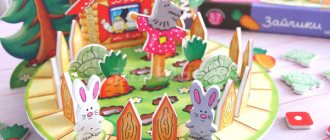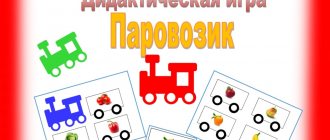My hometown
Didactic board and printed game for children of senior preschool age
Goal
: work to develop patriotic feelings in children, familiarize themselves with the history and sights of their native land, taking into account the requirements of the Federal State Educational Standard for the regional component.
Tasks
:
- form an idea of the history of your city;
- develop children's cognitive interest in the history of their homeland;
- teach the rules of social behavior;
- develop the ability to work in a team;
- develop the emotional sphere of the child’s personality;
- train fine motor skills of the hands;
- train memory, thinking, attention, imagination;
- consolidate children's knowledge about the history of their city of Tsaritsyn-Stalingrad-Volgograd;
- expand your vocabulary, activate your vocabulary.
The game task of the didactic game “My hometown!” is to provide opportunities for children to demonstrate responsibility, independence, and cooperation. The teacher monitors and evaluates the results.
My hometown
Composition of the game: - field-map
This is a playing field-card with pockets on which there are images of the city of Volgograd at different times (when it was called Tsaritsyn, Stalingrad.
- cards
Each card contains three small pictures with views of the central places of the city and attractions in different historical periods time (Note: the places depicted on the map field must match the contents of the cards; the same places at different historical times.)
- chips
Each chip is a round medallion icon with the emblem of the city.
Guidelines for the game
Preliminary work with children must be carried out. It is necessary to talk about the history of the city, about different time stages in its development, about significant events. It is also useful to study the map, mark the city center and main attractions on it. Show how the appearance of the city has changed over time, what the same iconic places for the city look like in different years.
All photographic materials that will form the basis of the printed board game must be studied in advance with the children. After all the materials have been studied, you can begin gaming activities. The game should begin under the guidance of an adult; later, as children master it, they can play independently.
All materials for the game should be located in relation to the players so that they are clearly visible and convenient to use, so it is better to play the game at the table.
Progress of the game
Number of players: subgroup of children from 2 to 8 people.
Children sit down so that everyone can clearly see and conveniently reach and choose a card. The teacher gives each player his own playing field-card with an image of Volgograd at a specific historical time. Children carefully study the picture. Then, independently or with the help of a teacher, they choose a card that depicts the same place in modern times, insert the card into the pocket, comparing one of the three pictures with the card field, and explain their choice.
For a correctly completed task, a participant in the didactic game “My Hometown!” gets a chip. And then he can take another card field for himself. The game ends when all the children have completed the task and there are no free card fields left. The one with the most chips wins. The game can be played several times. When all the children begin to cope with the task easily, the game can be complicated. Invite children (one player or group) to compose a story based on the image.
While using the game “My Hometown!” Children's activities can be organized independently or collectively, with a subgroup of children. Didactic material can be used directly in gaming activities or offered during educational activities (on the topics: development of cognitive and research activities, familiarization with the phenomena of social life). The game helps stimulate children's cognitive interest in the history of their homeland, forms cognitive culture and patriotic consciousness. The didactic material of the game is appropriate for the age of the children and is practical to use when working with children.
Elena Astakhova, teacher of preschool educational institution No. 263, Volgograd
Didactic game “City. Street"
Didactic game “Number. Sign. Subject" on the lexical topic "City. Street"
The game is intended for children aged 4-6 years with severe speech impairments, as well as for children of preschool and primary school age to develop the lexical and grammatical structure of speech.
Didactic game “Number. Sign. Subject" can be used both in individual and subgroup lessons with children.
Target:
This set of games will help an adult teach a child:
- agree nouns with numerals and adjectives in gender, number, case;
- select qualitative, relative, possessive adjectives for nouns;
- use ordinal numbers in speech, coordinate them with nouns and adjectives in gender, number, case;
- activate mental activity, associative thinking;
- make comparative sentences with the conjunction “a”.
Material for the game:
cards with game tasks in two subjects of the same lexical group; playing field and cut cards for independent selection and compilation of a plot series; sets of numbers.
Game description:
Game with ready-made models: each table contains tasks for two subjects of the same lexical group for a larger educational load. At the beginning of the game, the child needs to be clearly shown how associations can be used to indicate the characteristics of objects. For example, how can you depict a bitter taste, show the hardness, softness, juiciness of vegetables, color and shape.
Below are ready-made game cards:
- two large stores;
- seven grocery stores;
- one village store;
- four shoe stores;
- five furniture stores;
- eight flower shops;
- three children's libraries;
- five city schools;
- one music school;
- two sports schools;
- four wooden houses;
- one brick house;
- six block houses;
- five rural schools;
- three city libraries;
- nine paved roads;
- one rural library;
- two sandy roads;
- ten one-story houses;
- three two-story houses;
- one multi-storey building;
- two one-story houses.
The game requires compliance with the following steps:
- Name a word denoting a number (what number? - three).
- Name a word denoting an object (what is this? - library).
- Agree the noun with the numeral in gender (how many libraries? - three cucumbers).
- Name the words denoting the attribute of an object, coordinate them with numerals and nouns in gender, number (three libraries (which ones?) - urban).
- Agree the numeral with the adjectives and nouns in gender and number. (Say in complete sentences, starting with the number. - Three city libraries.)
- Using the same principle, consider another subject of the lexical group - the road.
- Make comparative sentences with the conjunction “a”. (There are three libraries, and nine roads, etc.)
Game with cut cards : played on the same principle as with ready-made models. Only here the child takes an active position and is given more independence.
First, you should invite the child to choose an item on a lexical topic and place it in a sector with an asterisk, then a number (place in the first sector) and select adjectives in the form of picture symbols (place in the longest sector of the playing field). The symbol pictures are first reviewed and what they mean is explained.
To better understand the progress of the game with cut cards, a sample is provided below.
Using the didactic game “Number. Sign. Subject" children will quickly master the skills of agreeing adjectives, nouns and numerals in gender, number, case; will learn to select adjectives for nouns and develop their associative thinking.
The development of associative thinking has a positive effect on the process of memorizing and reproducing necessary information.
On our website you can find other educational games from the “Number” series. Sign. Item". To do this, follow the highlighted link .
We wish everyone success.
Didactic games and exercises to familiarize preschoolers with the city of Naryan-Mar
Developed by: teacher Kirillova T.E.
| Didactic game “Do you know your city?” |
| Target: clarify and consolidate children’s knowledge about their hometown; practice composing a whole picture from individual parts; cultivate love for your hometown; develop memory and observation skills. Material : photos with city views, cut-out pictures Progress of the game. The teacher and the children look at photographs of city views. Then the children are given individual pictures. The teacher asks a question about a part of the city, the children find the corresponding picture and show it. Next, children assemble whole pictures from parts. |
| Didactic game “Experts of Naryan-Mar” |
| Target: consolidate and systematize children’s knowledge about the monuments of Naryan-Mar; develop attention and memory; cultivate love for your hometown Material : cut-out pictures with views of the city, chips. Progress of the game. The teacher divides the children into two teams. Offers to recognize the monument from a fragment of a photo or postcard. The team that completes the task receives a token. At the end of the game the results are summed up. |
| Didactic game "City Travel" |
| Target: consolidate children's knowledge of the names of streets and squares of their hometown; develop observation and memory. Material : cut-out pictures with views of streets and squares for each child Progress of the game. Children choose an envelope with cut-out pictures and, when given a signal, begin to collect them. The winner is the one who quickly collected and named correctly. You can play a game between teams. |
| Game exercise “Continue” |
| Target: develop the ability to understand the meaning of what is heard, remember, and compose a statement; consolidate children's knowledge about attractions. Examples of phrases to continue. Our city is called... The residents of our city are called... Naryan-Mar city... In our city there is... I like it in Naryan-Mar... |
| Didactic game "Keyhole" |
| Target: to form ideas about monuments in our city; develop memory, attention, spatial thinking; develop interest in your hometown. Material : photographs with views of the city's attractions, a sheet with a keyhole. Progress of the game. The presenter covers the photo with a sheet of paper with a keyhole. You can view the picture through the hole by gradually moving the sheet with the keyhole. Everyone looks at it at the same time, but everyone sees the sheet within 1 minute. The presenter offers to tell what is shown in the picture. At the end of the game, the picture opens and the presenter announces the winner, who explained in more detail. |
Let's decide together
The snow hasn't been cleared, there's a hole in the road, the streetlight isn't on? If you encounter a problem, report it!
The site is designed in accordance with:
with the Decree of the Government of the Russian Federation dated July 10, 2013 No. 582 “On approval of the rules for posting on the official website of an educational organization on the Internet information and telecommunications network and updating information about an educational organization (with amendments and additions dated October 20, 2015 No. 1120, dated May 17. 2017 No. 575, dated 08/07/2017 No. 944, 11/29/2018 No. 1439, dated 03/21/2019 No. 292, dated 07/11/2020 No. 1038);
with Article 29 of the Federal Law “On Education in the Russian Federation”, adopted by the State Duma on December 21, 2012, approved by the Federation Council on December 26, 2012;
with the order of the Federal Service for Supervision in Education and Science No. 831 of August 14, 2022 “On approval of requirements for the structure of an educational organization’s website on the Internet information and telecommunications network and the format for presenting information.”
Last update - 2022-01-18






